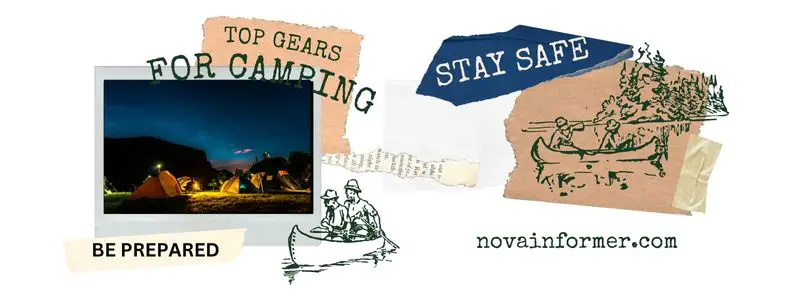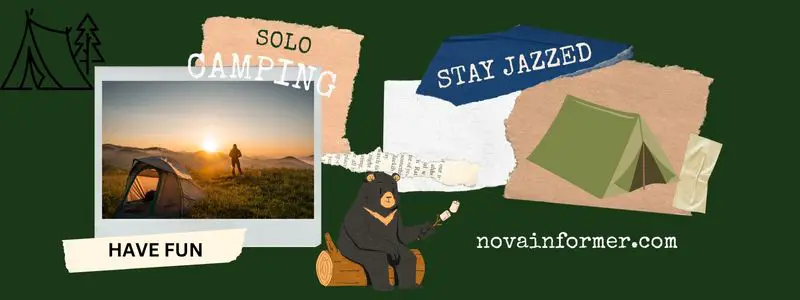Get ready for an epic camping adventure with our Survival Gear Showdown. Discover the top 10 tools for safety in the wilderness. #campinggear
Welcome, adventurous souls. As a seasoned camper with a passion for the great outdoors, I know that the wilderness can be both awe-inspiring and unpredictable.
Whether you’re a camping newbie or a seasoned pro, having the right survival gear can make or break your camping experience. Get ready for the ultimate Survival Gear Showdown, where I’ll walk you through the top 10 tools for safety in the wilderness.
Together, we’ll dive into the nitty-gritty of each essential item, ensuring you’re equipped with everything you need for a safe and memorable journey.
Before jump into the main gist of this article, take a look at the table of content.
Table of Contents:
- The Essentials: A Tent That Feels Like Home
- Sleep Tight: Picking the Perfect Sleeping Bag
- To Light or Not to Light: Choosing Your Camping Lantern
- Knife Skills 101: The Best Camping Knives
- Hydration Nation: Water Filtration Systems
- Let’s Get Cooking: Camp Stoves and Cookware
- Embrace the Elements: Outdoor Clothing & Footwear
- Navigation Simplified: GPS and Maps
- Communicate Like a Pro: Two-Way Radios
- First Aid Matters: Emergency Medical Kits
- The FAQ Corner
- Conclusion
The Essentials: A Tent That Feels Like Home
The humble tent is your home away from home. When it comes to selecting the perfect tent, you want to ensure it meets all your camping needs. Here are some crucial factors to consider:
- The Right Size Matters: Look for a tent that comfortably accommodates the number of campers and their gear. A little extra space never hurts.
- Durability: Materials and Construction: Opt for tents made from sturdy, waterproof materials like nylon or polyester. Check for durable poles and strong stitching to withstand the elements.
- Set Up with Ease: Nobody wants to wrestle with tent poles after a long day of hiking. Choose a tent with a simple and quick set-up design.
- Ventilation for Comfort: Proper ventilation prevents condensation buildup and keeps the tent fresh and comfortable.
- Weather Resistance: Make sure your tent is designed to handle various weather conditions, from rain to wind and even snow.
Sleep Tight: Picking the Perfect Sleeping Bag
After a day of adventure, a good night’s sleep is essential for recharging. Here’s what to consider when choosing a sleeping bag:
- Temperature Ratings Explained: Understand temperature ratings to match the bag with your camping destination’s climate.
- Types of Insulation: Down or synthetic? Each has its pros and cons, so pick the one that suits your needs.
- Weight and Packability: For backpackers, lightweight and compressible sleeping bags are a game-changer.
- Shape and Size: Choose a bag that offers ample space for comfort without leaving you feeling claustrophobic.
- Additional Features: Look for extras like draft tubes, stash pockets, and hoods to enhance your sleeping experience.
To Light or Not to Light: Choosing Your Camping Lantern
When darkness falls, a reliable light source becomes your best friend. Here’s what to consider when picking the perfect camping lantern:
- Lantern Types: Traditional vs. LED: Decide between classic gas lanterns and modern, energy-efficient LED lanterns.
- Brightness Levels and Beam Distance: Find a lantern that offers adjustable brightness and ample beam distance for your needs.
- Power Source Options: Consider battery-operated lanterns or rechargeable ones with solar panels.
- Runtime and Battery Life: Opt for lanterns with longer runtimes to avoid constant battery changes.
- Size and Portability: Choose a lantern that’s compact and easy to carry around the campsite.
Knife Skills 101: The Best Camping Knives
A trusty camping knife is like having a versatile toolset at your fingertips. Here’s what to look for in the perfect camping knife:
- Fixed Blade vs. Folding Knife: Decide between the strength and durability of fixed blades or the portability of folding knives.
- Blade Material and Design: High-quality stainless steel blades are ideal for camping. Consider blade shapes like drop-point or clip-point.
- Handle and Grip Comfort: Look for a knife with an ergonomic handle that feels comfortable and secure in your hand.
- Blade Length and Purpose: Choose a blade length that suits your camping tasks, from food prep to cutting ropes.
- Safety and Maintenance Tips: Learn proper knife handling and maintenance to keep your knife in top condition and avoid accidents.
Hydration Nation: Water Filtration Systems
Staying hydrated is vital, but not all water sources in the wild are safe to drink. Here’s what to consider when selecting a water filtration system:
- Types of Water Filters: Choose from pump filters, gravity filters, and water bottles with built-in filters.
- Filtering Capacity and Speed: Check the filter’s capacity and flow rate to meet your water needs.
- Maintenance and Cleaning: Regularly clean and replace filter elements to keep your water safe and tasty.
- Portable Water Bottles with Filters: Invest in a bottle with a filter for on-the-go hydration.
- Water Purification Tablets as Backup: Carry water purification tablets as a backup plan for emergencies.
Let’s Get Cooking: Camp Stoves and Cookware
Hungry campers are grumpy campers, so it’s essential to have a reliable cooking setup. Here’s what to look for in camp stoves and cookware:
- Types of Camp Stoves: Propane vs. Liquid Fuel: Choose between convenient propane stoves or versatile liquid fuel stoves.
- Burner Count and BTU Output: Consider the number of burners and the stove’s heating power for efficient cooking.
- Cooking Surface and Wind Resistance: Look for stoves with stable cooking surfaces and wind shields to prevent food disasters.
- Lightweight and Compact Cookware: Opt for lightweight cookware that won’t weigh you down on the trail.
- Essential Cooking Utensils: Pack cooking essentials like spatulas, tongs, and a campfire coffee pot.
Embrace the Elements: Outdoor Clothing & Footwear
Mother Nature can be unpredictable, so dressing appropriately is essential. Here’s what to consider when choosing outdoor clothing and footwear:
- Layering System: Base, Mid, and Outer Layers: Dress in layers to stay comfortable in changing weather conditions.
- Moisture-Wicking Fabrics and Breathability: Opt for moisture-wicking fabrics to keep sweat away from your skin.
- Insulation and Warmth: Choose insulation materials like down or synthetic for warmth.
- Waterproof and Windproof Materials: Invest in waterproof and windproof outer layers to stay dry and cozy.
- Hiking Boots: Comfort and Support: Find hiking boots with good ankle support and a comfortable fit for long hikes.
Navigation Simplified: GPS and Maps
Lost in the wilderness? Not on my watch. Here’s what you need to know about navigation tools:
- Benefits of GPS Devices: GPS devices offer real-time tracking, waypoints, and navigation aids.
- Topographic Maps: Reading and Using Them: Learn to interpret contour lines and elevation to navigate like a pro.
- Offline Map Apps for Smartphones: Use offline map apps as a backup to stay on course, even without internet access.
- GPS Accuracy and Signal Strength: Ensure your GPS device has a strong signal and accurate location data.
- Backup Navigation Techniques: Brush up on traditional navigation methods like compass and sun orientation.
Communicate Like a Pro: Two-Way Radios
Staying connected with your camping buddies is crucial, especially in remote areas. Here’s what to consider when choosing two-way radios:
Range and Channel Options: Look for radios with sufficient range to keep you connected.
- Radio Power and Battery Life: Opt for radios with long battery life and rechargeable options.
- Weather Alert and Emergency Features: Some radios offer weather alerts and emergency channels for safety.
- Hands-Free Options: Headsets and Carabiner Clips: Use hands-free accessories for convenience and safety.
- Radio Licensing Considerations: Depending on the radio type, you may need to obtain a license to operate legally.
First Aid Matters: Emergency Medical Kits
Safety first, my friends. Here’s what to consider when putting together your emergency medical kit:
- Pre-Made vs. Custom Kits: Decide whether to buy a pre-made kit or assemble one tailored to your specific needs.
- Essential First Aid Supplies: Stock up on bandages, antiseptics, adhesive tape, and other essentials.
- Medications and Personal Prescription Items: Include any necessary medications and personal prescriptions.
- Wilderness-Specific First Aid Additions: Add items like insect repellent, blister treatments, and allergy medication.
- First Aid Training and Certification: Take a first aid course to gain knowledge and confidence in emergency situations.
The FAQ Corner
1. What type of tent is best for camping in all seasons?
Look for a 4-season tent designed to withstand extreme weather conditions. Brands like North Face and MSR have great options.
2. Can I wash my sleeping bag in the washing machine?
Most sleeping bags require delicate care and are best hand-washed or taken to a professional cleaner.
3. Is a headlamp or a handheld flashlight better for camping?
It depends on personal preference and activities. Headlamps are great for hands-free tasks, while handheld flashlights offer more focused beams.
4. What’s the difference between a fixed blade and a folding knife?
Fixed blades are sturdier and more robust, ideal for heavy-duty tasks. Folding knives are more portable and suitable for everyday use.
5. How often should I replace my water filter?
It varies depending on usage, but a general rule of thumb is to replace filters every 1,000 liters or as recommended by the manufacturer.
6. Can I use regular cookware on a camp stove?
Yes, but it’s best to use lightweight, non-stick cookware for easier cleanup and portability.
7. Should I pack cotton clothing for camping?
Cotton retains moisture and can make you feel colder, so it’s best to stick to moisture-wicking and quick-drying fabrics like polyester and merino wool.
8. What’s the difference between a GPS and a smartphone with GPS capabilities?
GPS devices are typically more accurate and have longer battery life compared to smartphones, which may drain quickly when using GPS.
9. Can I use two-way radios in national parks?
Yes, but it’s essential to check park regulations, as some areas may have restrictions on radio frequencies.
10. Do I need to take a first aid course before camping?
While it’s not mandatory, taking a basic first aid course can provide valuable skills and knowledge for handling emergencies.
11. Can I customize my first aid kit with additional items?
Tailor your first aid kit to your specific needs, but don’t forget the basics.
Conclusion
Congratulations, fearless campers. You’ve made it to the end of our Survival Gear Showdown, and I hope you’re feeling pumped to conquer the wilderness.
Armed with this knowledge, you’re ready to face any outdoor challenge and make unforgettable memories.
Remember, the right gear can turn a good camping trip into an extraordinary one. So, pack your bags, embrace the unknown, and let nature work its magic on your soul.
And in the wise words of the legendary Amelia Earhart, “Adventure is worthwhile in itself.” Embrace the thrill of exploration, appreciate nature’s wonders, and let the wilderness ignite your spirit of adventure.
Quote
“Adventure is Worthwhile in Itself” – Amelia Earhart
Happy camping, fellow adventurers. May your journeys be filled with laughter, camaraderie, and the wonders of the great outdoors.



